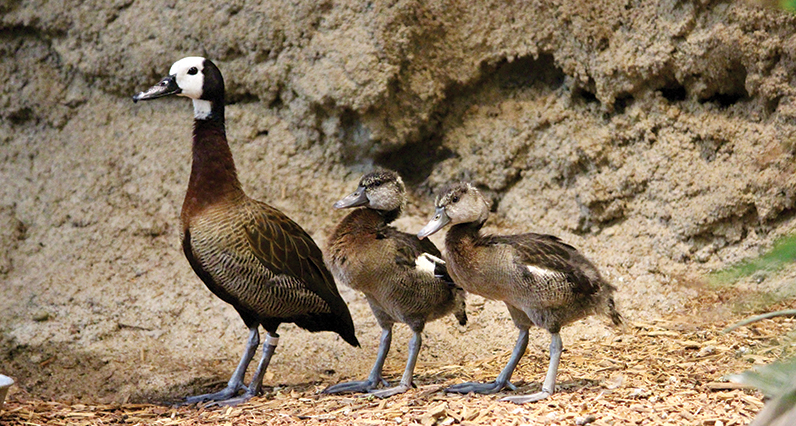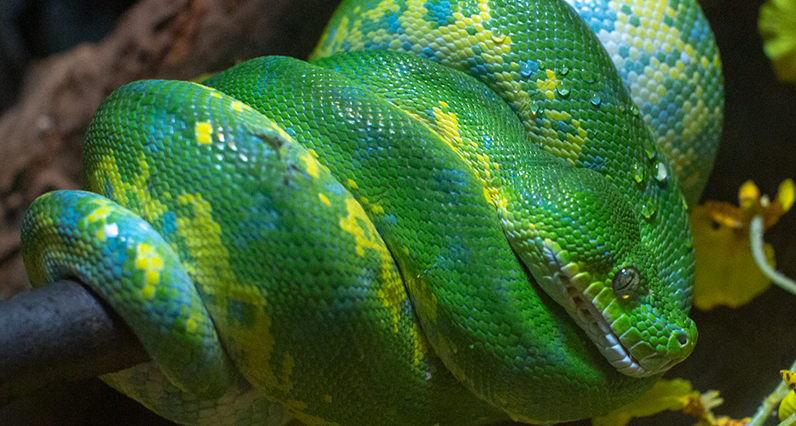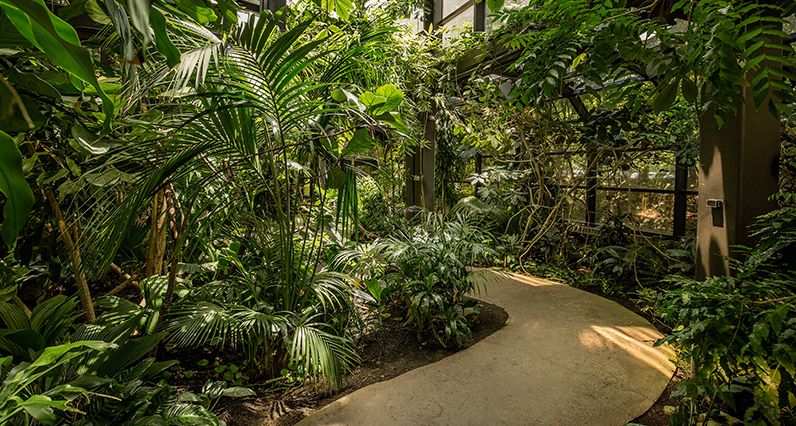If you’re like most Zoo guests in the spring, you head to The RainForest. At a cozy and constant 80 degrees all year, The RainForest is a haven from Cleveland’s sometimes frigid and often snowy weather. Regular visitors to this jungle getaway know of the many sights and sounds it has to offer, but here are five species not to miss.
The RainForest medicine trail highlights real plants that are found in native rain forests.
Birds of a feather
As you enter The RainForest and marvel at the 25-foot waterfall, take a right and wave at the monkeys on your way to the Medicine Trail. The Medicine Trail is a path surrounded by real plants that are native to tropical rain forests around the world. These plants provide ingredients for many products that people use every day, including around 25% of the world’s medicines. Follow this winding path until you come to a clearing at the base of a large staircase, and head upstairs.
The RainForest second floor is an aviary filled with a large assortment of animals, including capybaras, turtles, agoutis, and a variety of birds that fly free over your head.
One of the bird species that calls this place home is the white-faced whistling duck, our first featured creature. You can identify them by their signature white faces and long legs and necks. They have a black head and bill and a rust-colored body with a chestnut front.

White-faced whistling duck with her chicks
In the wild, the white-faced whistling duck can be found in small groups, and the Zoo’s ducks are no different. The ducks stick together and are never far from one another — birds of a feather, right? In Africa and South America, the whistling ducks live in a variety of freshwater wetlands and will sometimes roost in trees. Our resident ducks also like the water features in the aviary and can sometimes be spotted perched on one of the vines or tree limbs stretched over the guest path.
The ducks travel throughout the aviary and will even walk down the footpath. They are very alert and quick-footed. If you’re lucky, you might hear the ducks give their notable whistle call. The call is a quick succession of three, high-pitched whistles. (It sounds similar to a squeaky toy for a dog.)
Leopard love
As you cross through the curtain at the tail end of the Aviary, take a right at the next fork and you’ll find Ryker the clouded leopard. Ryker is a little over one-year-old and arrived here in Cleveland last April. He is the first clouded leopard that the Zoo has had since 2011. Clouded leopards live in jungles near the Himalayan mountains in southeast Asia and are a vulnerable species in the wild due largely to habitat loss and poaching.
Clouded Leopard "Ryker" at Cleveland Metroparks Zoo
Clouded leopards grow two to three feet long with an additional three feet in length from their tail. Ryker still has a little more to grow, but clouded leopards are only medium-sized cats, much smaller than the snow leopards or Amur leopard in Asian Highlands. In the wild, clouded leopards love to spend time in the trees and are very agile and excellent climbers - their long tails help with balance while climbing. You can often find Ryker climbing and leaping across the many trees and platforms in his habitat.
Ryker is young and full of energy and often reacts to people that stop by and see him. You will probably hear him vocalizing at your arrival, as if to greet you. Ryker usually cries out in a loud sort of meow or will emit a series of chuffs. These sound like a cross between a snort and a purr. He is very energetic and curious and is fun to watch.
RainForest favorites
Continue down the path and it will open to the hub of The RainForest, the two-story orangutan habitat where you will find the ever popular Merah. Merah is a 4-year-old Bornean orangutan, and she lives with her mother, Kera Wak, her father, Tiram, and the Zoo’s fourth orangutan, Kayla. Merah is much smaller than her roommates, similar to a 4-year-old human. But the small size won’t last long. Orangutans can grow to be 5.5 feet tall and the males can weigh more than 300 pounds. Their arm span can reach wider than eight feet!
Keeper Chat: Merah the Bornean orangutan
This wide reach allows for orangutans to be very capable climbers and, in the wild, they spend most of their time in the trees. The Zoo tries to replicate this habitat with the large tree-like structure that has limbs that extend in many directions and make for convenient platforms for climbing and sitting. There are also ropes on which the orangutans can swing and slide.
Merah is a joy to observe. She is very playful and loves to interact with the other apes, climbing all over the habitat and sometimes the other orangs. She is always entertaining and should not be missed on your visit to The RainForest.
Otter entertainment
After viewing the orangutans, turn around and enjoy another family. The Zoo’s clan of Asian small-clawed otters was a crowd favorite when the babies were born in November 2017. Adhi, Bejo, and Cipto are the three male offspring of mom Bitzy and dad Kibble. While they are now as big as their parents, they are still rambunctious as ever.
Otter enrichment - breakfast time!
Despite being the world’s smallest otter species, Asian small-clawed otters can be anywhere from 1.5 to 2-feet-long in head and body length. Their tails can add another foot to their length. Their sleek, flexible bodies are perfect for slipping and sliding along wetlands and through bodies of freshwater. The otters have semi-webbed paws and long tails that help steer them through the water as they swim. The zoo’s habitat has a large pool where you can observe the otters swimming with an effortless grace. There is also a cascade waterfall which the otters sometimes use like a water slide.
The Zoo’s otters are an animated bunch, and if you stand along the wall at the end of their habitat, they may scramble over to get a closer look. The otters will sometimes stand on their hind legs and squeak, perhaps interested in their spectators. But don’t be concerned if it looks like these comical critters are trying to relieve a terrible itch; they are only rubbing themselves around their territory to mark their scent.
Can’t find them in the water one day? Be sure to check for the otter family in its burrow, viewable through a window. When not swimming, the trio enjoy taking naps, curled up together in a knotted mound.
Seeing green
Exit through the nearby door and head downstairs to reach our final destination. The lower level of The RainForest is largely populated with ground-dwellers like insects, amphibians, and lots of reptiles. Stroll down the corridor, past the poison dart frogs and fruit bats, past the dwarf crocodile and piranhas, and past the prehensile-tailed skink until you reach the green tree python. With its emerald green coloring flecked with topaz yellow and sapphire blue scales, this snake is truly a gem of The RainForest.

Green tree python wrapped around a branch
Photo by member Jim Carey
The colorful scales work as camouflage in the real jungle, blending in with leafy surroundings as the python awaits its next unsuspecting prey. The Zoo’s habitat contains numerous tree branches for our local python to display similar behavior. The green tree python has a unique way of coiling itself on a limb where it drapes its body in neat folds and rests its head atop their peak. Green tree pythons can grow as long as 6.5 feet but are commonly measured around half of that.
If you’re worried about a poisonous bite, don’t be. Green tree pythons are nonvenomous constrictors, meaning they wrap their body around their prey to eat it. Pay close attention to the pits on our python’s lower jaw. These are thermosensors that detect heat changes in the environment and in the wild, they aid the snake in catching a meal. Even if snakes are not really your thing, we think you’ll have to admit that this is one beautiful and fascinating species!
Blog written by Adam Schlaker, Member & Donor Services Representative







